2003 FORD WINDSTAR child lock
[x] Cancel search: child lockPage 8 of 240
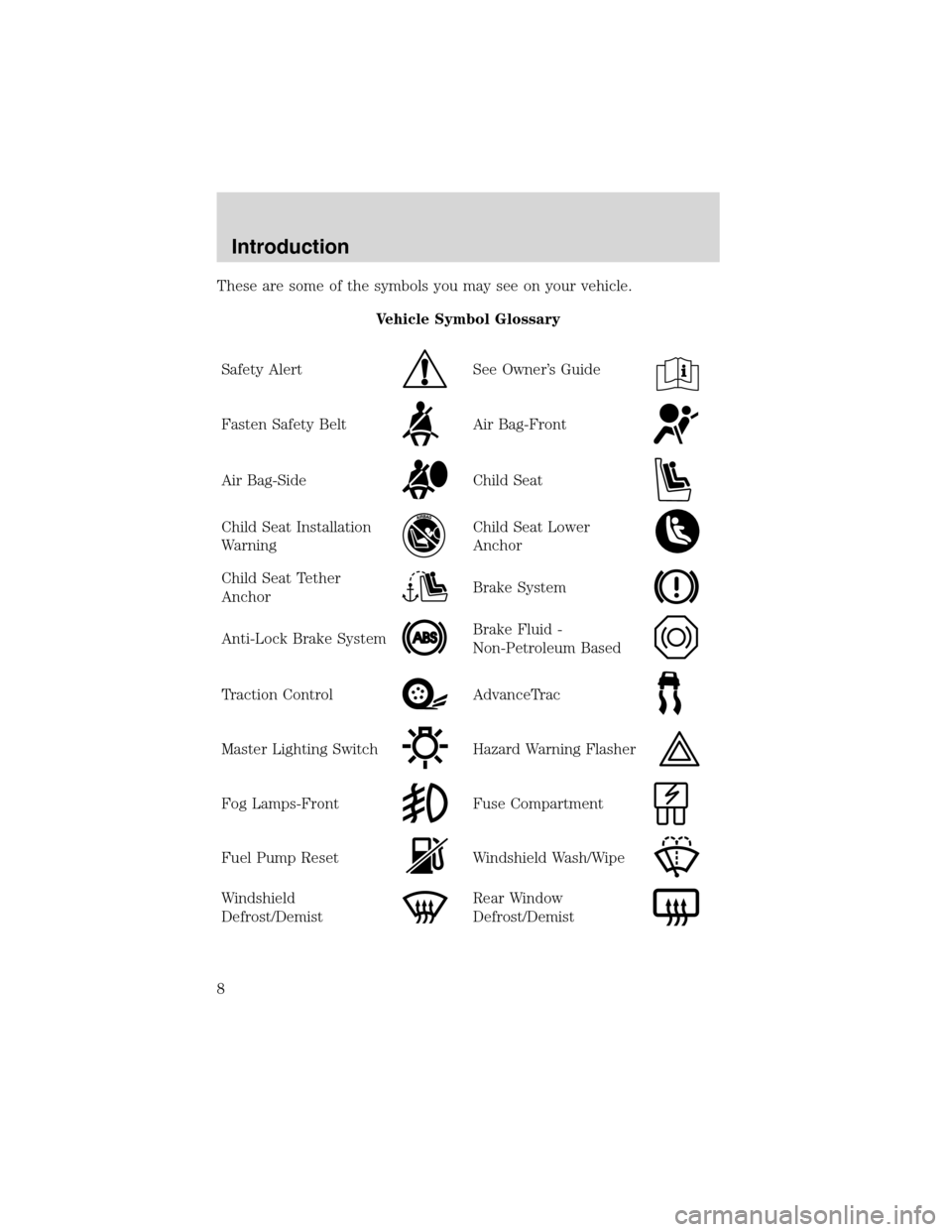
These are some of the symbols you may see on your vehicle.
Vehicle Symbol Glossary
Safety Alert
See Owner’s Guide
Fasten Safety BeltAir Bag-Front
Air Bag-SideChild Seat
Child Seat Installation
WarningChild Seat Lower
Anchor
Child Seat Tether
AnchorBrake System
Anti-Lock Brake SystemBrake Fluid -
Non-Petroleum Based
Traction ControlAdvanceTrac
Master Lighting SwitchHazard Warning Flasher
Fog Lamps-FrontFuse Compartment
Fuel Pump ResetWindshield Wash/Wipe
Windshield
Defrost/DemistRear Window
Defrost/Demist
Introduction
8
Page 9 of 240
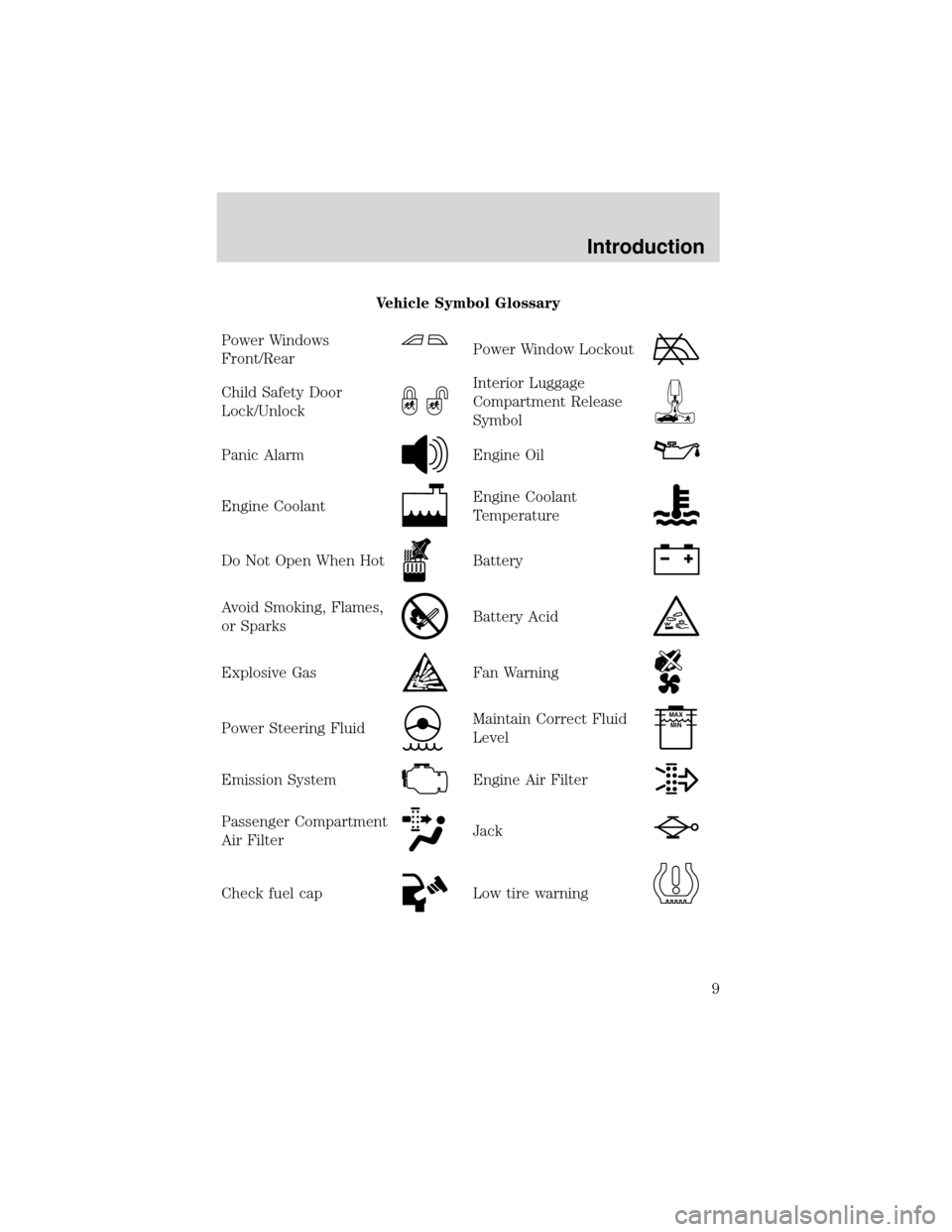
Vehicle Symbol Glossary
Power Windows
Front/Rear
Power Window Lockout
Child Safety Door
Lock/UnlockInterior Luggage
Compartment Release
Symbol
Panic AlarmEngine Oil
Engine CoolantEngine Coolant
Temperature
Do Not Open When HotBattery
Avoid Smoking, Flames,
or SparksBattery Acid
Explosive GasFan Warning
Power Steering FluidMaintain Correct Fluid
LevelMAX
MIN
Emission SystemEngine Air Filter
Passenger Compartment
Air FilterJack
Check fuel capLow tire warning
Introduction
9
Page 41 of 240
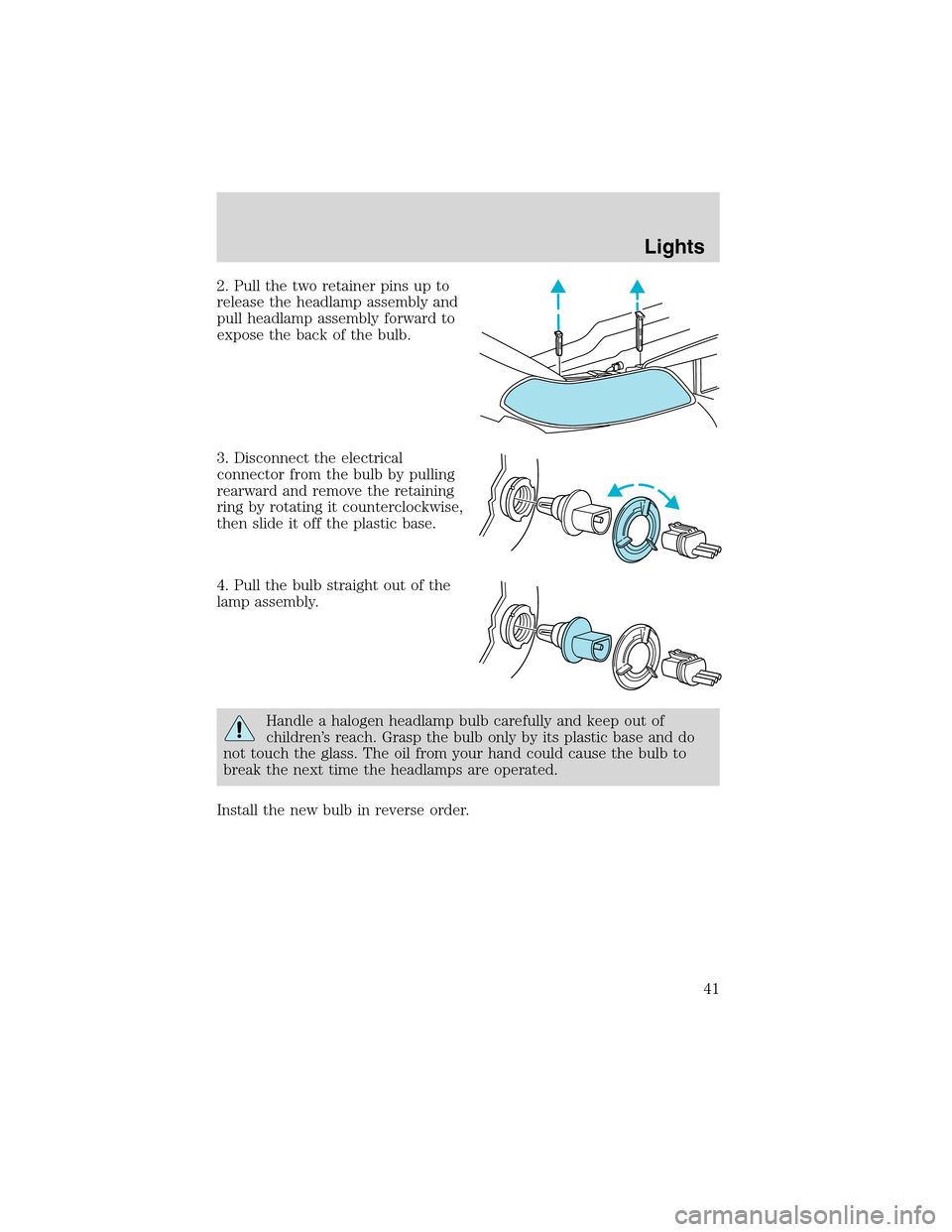
2. Pull the two retainer pins up to
release the headlamp assembly and
pull headlamp assembly forward to
expose the back of the bulb.
3. Disconnect the electrical
connector from the bulb by pulling
rearward and remove the retaining
ring by rotating it counterclockwise,
then slide it off the plastic base.
4. Pull the bulb straight out of the
lamp assembly.
Handle a halogen headlamp bulb carefully and keep out of
children’s reach. Grasp the bulb only by its plastic base and do
not touch the glass. The oil from your hand could cause the bulb to
break the next time the headlamps are operated.
Install the new bulb in reverse order.
Lights
41
Page 48 of 240

To disable
Press the OFF control in the
overhead console to turn off the
PSD. This prevents opening the PSD
using the rear seat control(s), but
the door(s) can be opened manually
with the handle. With the child
safety lock engaged, only the
outside handle will open the door.
The controls in the overhead console and the Remote Entry System will
remain functional with the system shut OFF.
Opening and closing the PSD
The sliding door must be unlocked for it to operate. The key does not
have to be in the ignition. To help avoid accidental operation of the
Power Sliding Door, disable the PSD second row passenger controls.
When the key is in the ignition in RUN, the PSD will only open if the
transaxle is in PARK (P). The transaxle does not have to be in PARK (P)
to close the door.
With the ON/OFF control in the ON
position, either sliding door can be
opened or closed by:
•pushing and releasing the
overhead console right or left
hand control
•pushing and releasing the right or
left hand second row passenger
control
•manually pulling the inside or outside sliding door handle and release
•operating the remote transmitter. Refer toRemote Entry Systemin
theLocks and securitychapter.
The door will open or close fully using these options.
With the ON/OFF control in the OFF position, either sliding door can be
operated by pulling the inside or outside handle and sliding the door
back manually.
The left hand PSD will not open (manually or power) if the fuel door is
open regardless of the ON/OFF control position.
Safety/Obstructions
If anything obstructs the Power Sliding Door while it is closing, the door
will automatically reverse to the open position, provided it meets
sufficient resistance.
Driver Controls
48
Page 49 of 240
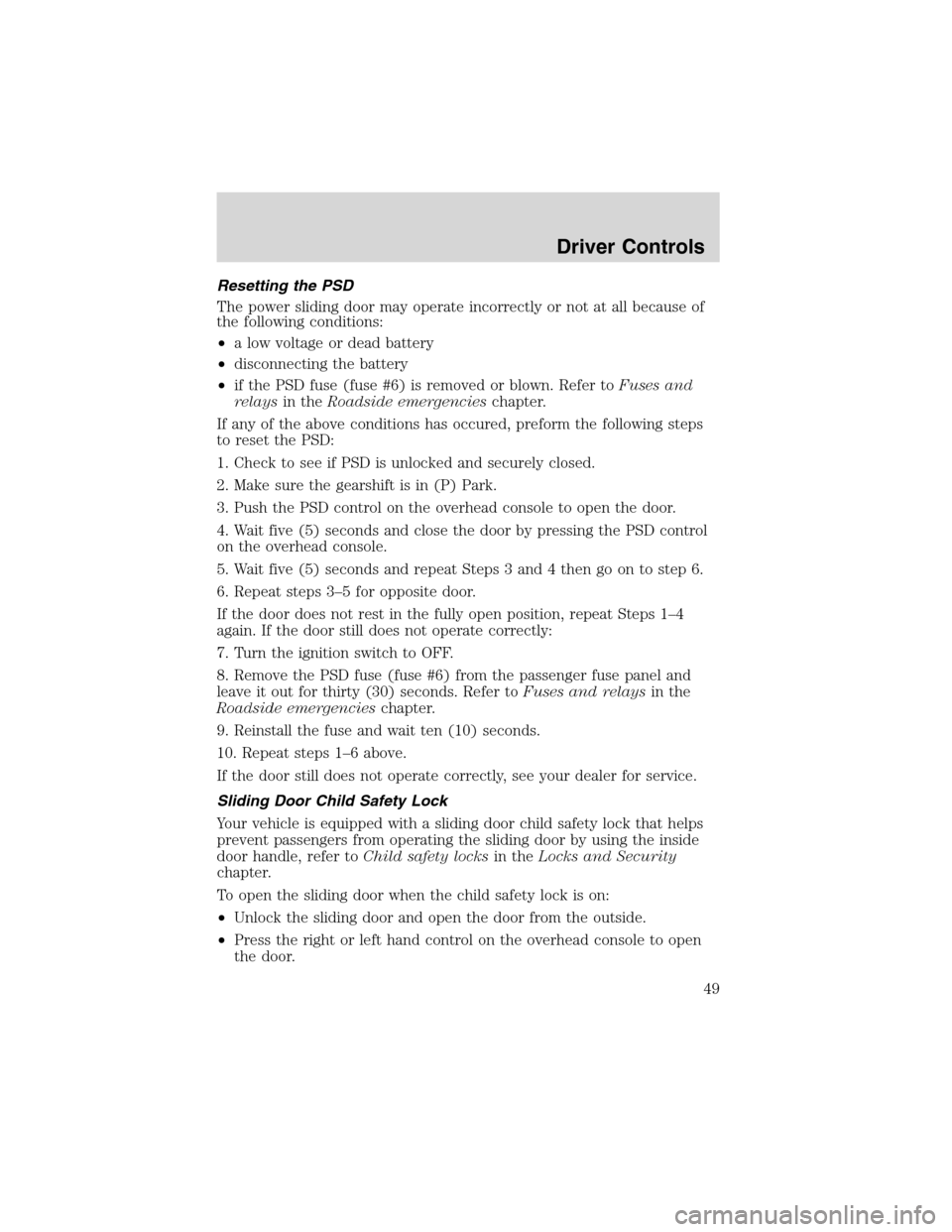
Resetting the PSD
The power sliding door may operate incorrectly or not at all because of
the following conditions:
•a low voltage or dead battery
•disconnecting the battery
•if the PSD fuse (fuse #6) is removed or blown. Refer toFuses and
relaysin theRoadside emergencieschapter.
If any of the above conditions has occured, preform the following steps
to reset the PSD:
1. Check to see if PSD is unlocked and securely closed.
2. Make sure the gearshift is in (P) Park.
3. Push the PSD control on the overhead console to open the door.
4. Wait five (5) seconds and close the door by pressing the PSD control
on the overhead console.
5. Wait five (5) seconds and repeat Steps 3 and 4 then go on to step 6.
6. Repeat steps 3–5 for opposite door.
If the door does not rest in the fully open position, repeat Steps 1–4
again. If the door still does not operate correctly:
7. Turn the ignition switch to OFF.
8. Remove the PSD fuse (fuse #6) from the passenger fuse panel and
leave it out for thirty (30) seconds. Refer toFuses and relaysin the
Roadside emergencieschapter.
9. Reinstall the fuse and wait ten (10) seconds.
10. Repeat steps 1–6 above.
If the door still does not operate correctly, see your dealer for service.
Sliding Door Child Safety Lock
Your vehicle is equipped with a sliding door child safety lock that helps
prevent passengers from operating the sliding door by using the inside
door handle, refer toChild safety locksin theLocks and Security
chapter.
To open the sliding door when the child safety lock is on:
•Unlock the sliding door and open the door from the outside.
•Press the right or left hand control on the overhead console to open
the door.
Driver Controls
49
Page 76 of 240
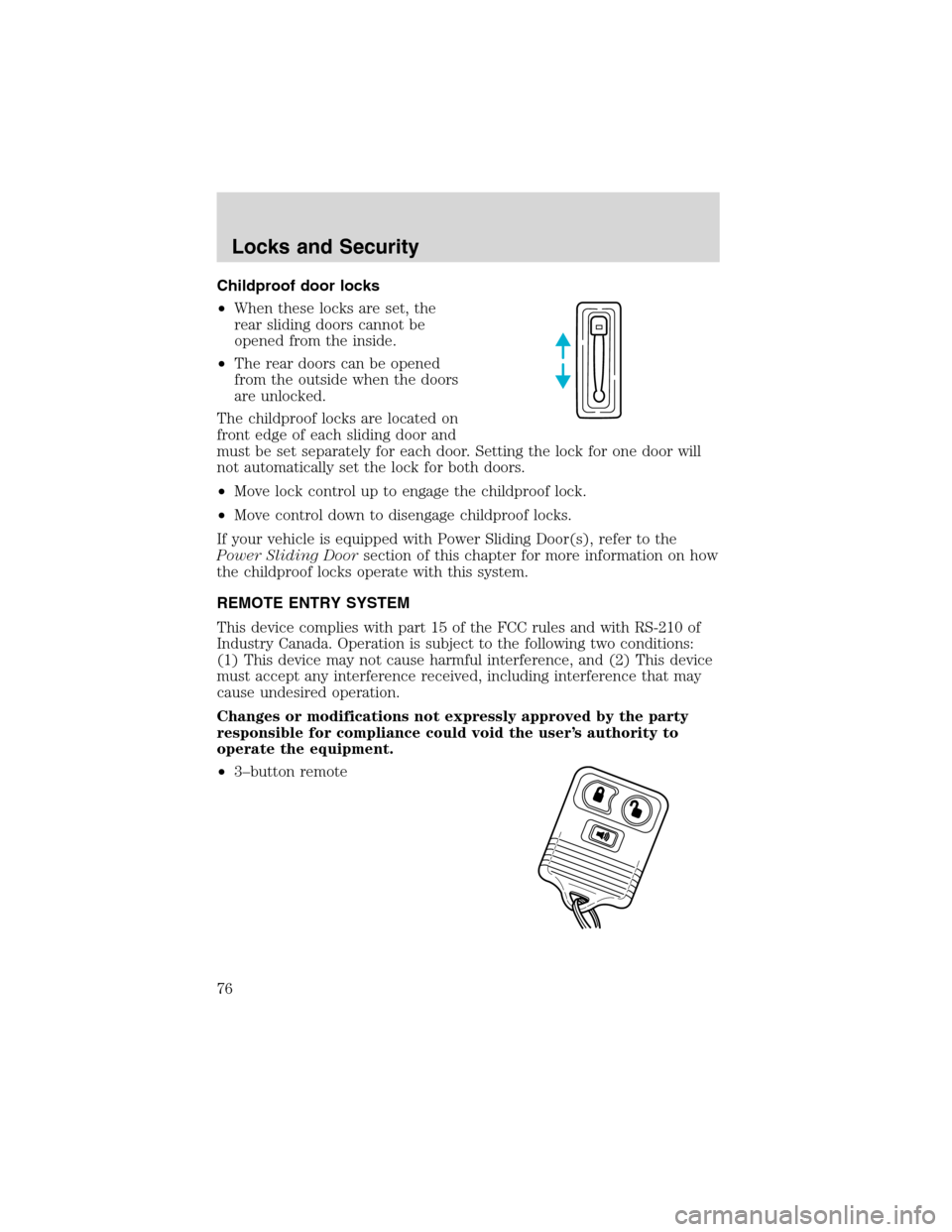
Childproof door locks
•When these locks are set, the
rear sliding doors cannot be
opened from the inside.
•The rear doors can be opened
from the outside when the doors
are unlocked.
The childproof locks are located on
front edge of each sliding door and
must be set separately for each door. Setting the lock for one door will
not automatically set the lock for both doors.
•Move lock control up to engage the childproof lock.
•Move control down to disengage childproof locks.
If your vehicle is equipped with Power Sliding Door(s), refer to the
Power Sliding Doorsection of this chapter for more information on how
the childproof locks operate with this system.
REMOTE ENTRY SYSTEM
This device complies with part 15 of the FCC rules and with RS-210 of
Industry Canada. Operation is subject to the following two conditions:
(1) This device may not cause harmful interference, and (2) This device
must accept any interference received, including interference that may
cause undesired operation.
Changes or modifications not expressly approved by the party
responsible for compliance could void the user’s authority to
operate the equipment.
•3–button remote
Locks and Security
76
Page 227 of 240
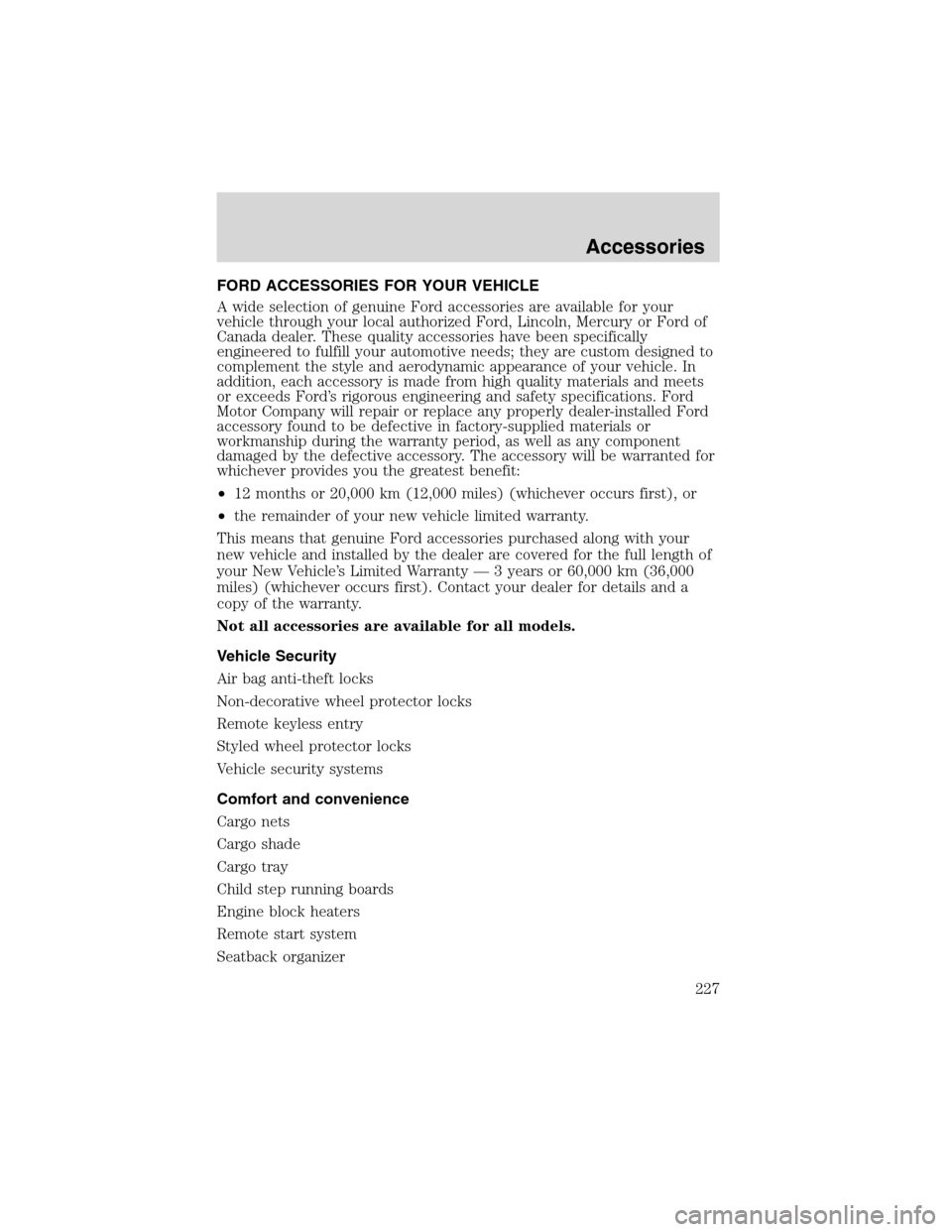
FORD ACCESSORIES FOR YOUR VEHICLE
A wide selection of genuine Ford accessories are available for your
vehicle through your local authorized Ford, Lincoln, Mercury or Ford of
Canada dealer. These quality accessories have been specifically
engineered to fulfill your automotive needs; they are custom designed to
complement the style and aerodynamic appearance of your vehicle. In
addition, each accessory is made from high quality materials and meets
or exceeds Ford’s rigorous engineering and safety specifications. Ford
Motor Company will repair or replace any properly dealer-installed Ford
accessory found to be defective in factory-supplied materials or
workmanship during the warranty period, as well as any component
damaged by the defective accessory. The accessory will be warranted for
whichever provides you the greatest benefit:
•12 months or 20,000 km (12,000 miles) (whichever occurs first), or
•the remainder of your new vehicle limited warranty.
This means that genuine Ford accessories purchased along with your
new vehicle and installed by the dealer are covered for the full length of
your New Vehicle’s Limited Warranty—3 years or 60,000 km (36,000
miles) (whichever occurs first). Contact your dealer for details and a
copy of the warranty.
Not all accessories are available for all models.
Vehicle Security
Air bag anti-theft locks
Non-decorative wheel protector locks
Remote keyless entry
Styled wheel protector locks
Vehicle security systems
Comfort and convenience
Cargo nets
Cargo shade
Cargo tray
Child step running boards
Engine block heaters
Remote start system
Seatback organizer
Accessories
227
Page 230 of 240
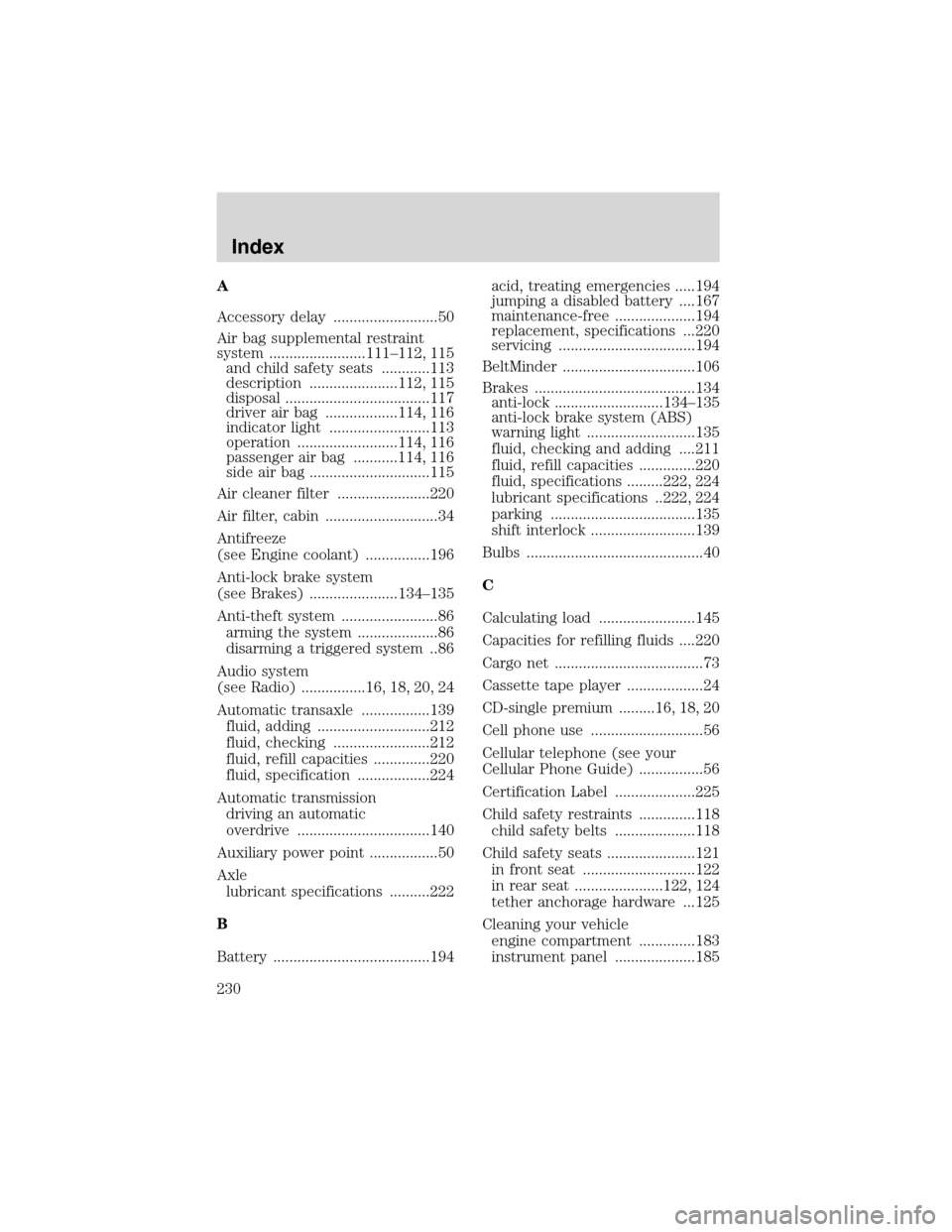
A
Accessory delay ..........................50
Air bag supplemental restraint
system ........................111–112, 115
and child safety seats ............113
description ......................112, 115
disposal ....................................117
driver air bag ..................114, 116
indicator light .........................113
operation .........................114, 116
passenger air bag ...........114, 116
side air bag ..............................115
Air cleaner filter .......................220
Air filter, cabin ............................34
Antifreeze
(see Engine coolant) ................196
Anti-lock brake system
(see Brakes) ......................134–135
Anti-theft system ........................86
arming the system ....................86
disarming a triggered system ..86
Audio system
(see Radio) ................16, 18, 20, 24
Automatic transaxle .................139
fluid, adding ............................212
fluid, checking ........................212
fluid, refill capacities ..............220
fluid, specification ..................224
Automatic transmission
driving an automatic
overdrive .................................140
Auxiliary power point .................50
Axle
lubricant specifications ..........222
B
Battery .......................................194acid, treating emergencies .....194
jumping a disabled battery ....167
maintenance-free ....................194
replacement, specifications ...220
servicing ..................................194
BeltMinder .................................106
Brakes ........................................134
anti-lock ...........................134–135
anti-lock brake system (ABS)
warning light ...........................135
fluid, checking and adding ....211
fluid, refill capacities ..............220
fluid, specifications .........222, 224
lubricant specifications ..222, 224
parking ....................................135
shift interlock ..........................139
Bulbs ............................................40
C
Calculating load ........................145
Capacities for refilling fluids ....220
Cargo net .....................................73
Cassette tape player ...................24
CD-single premium .........16, 18, 20
Cell phone use ............................56
Cellular telephone (see your
Cellular Phone Guide) ................56
Certification Label ....................225
Child safety restraints ..............118
child safety belts ....................118
Child safety seats ......................121
in front seat ............................122
in rear seat ......................122, 124
tether anchorage hardware ...125
Cleaning your vehicle
engine compartment ..............183
instrument panel ....................185
Index
230